Handbook on environmental assessment of products
4. Carry out environmental assessment with a PC tool
By filling in the MECO chart, you have now established a paper model for the environmental
assessment of your product.
The information about consumption of material and energy, waste, and emissions to air and water can be converted into environmental impacts by preparing a model in a PC-based tool.
This chapter is based on the Danish Environmental Protection Agency PC tool – the EDIP PC tool (beta version 2.11, 1998 – which was developed on the basis of the EDIP method [Wenzel et al., 1996].
4.1 Advantages of the PC tool
There are certain advantages to modelling your environmental assessment in a PC tool:
| The model is constructed systematically | |
| It is possible to draw data from a database, thereby reducing the need to collect further data | |
| Waste and emissions to air and water are included in the calculations of environmental impacts | |
| It is easy to carry out subsequent adjustments if e.g. new, more detailed information on inputs and outputs become available or if e.g. one ancillary material is replaced by another. | |
| It is easy to introduce changes, which means that the expected environmental impact of a future change can be compared to the "old" product. |
It should, however, be borne in mind that use of any PC tool will always require a lot of resources in the form of training on how to use the software, PC capacity, and expenses for purchasing licences for the selected tool – prices vary considerably from tool to tool. |
4.2 Before you begin
If you have decided to carry out model simulations in a PC tool, the MECO chart provides a good place to start. In the MECO chart, you have already identified some of the areas which affect the environmental impact of the product. You can choose to model the entire life-cycle, or just parts of it. If the entire life-cycle is not modelled, it is important to make sure that the most significant areas – in environmental terms – have been identified in the MECO chart. Partial modelling will typically be carried out when comparing two very similar products: model simulations will only be prepared for those parts of their life-cycles which are different from each other. You do, however, need to be aware of certain issues.
4.2.1 Choosing a PC tool
Choosing a PC tool is not always easy, as there are many different tools available on the market today. It is, however, important to identify what the tool should be able to do and which data are important to facilitate the easiest possible modelling process.
Data collection requires many resources. This is why an extensive database can save time if you do not already have all the data necessary for the product. It is also a good idea to spend a little time finding out what the PC tool requires from users. This will give you some indication of the time necessary to be able to carry out model simulations with the tool. In 2000, the most common PC tools in Denmark were:
| EDIP PC tool (beta version) | |
| Simapro |
The EDIP PC tool comes with a manual with step-by-step instructions on how to use the tool [Pedersen, M.A., 1998]. This manual provides instructions for installation and use of the calculation programme and the database.
For Simapro, a set of manuals is available. These manuals describe the software structure and how it should be used. They also describe the database and the programme functions [PRé Consultants B.V.].
If you want to know more about the PC tools available on the market today, please refer to the article "Results of a test of LCA software with statistical functionality" [Weidema, B.P., 1997]
Below are instructions on modelling, interpretation, and other issues related to use of a PC tool.
4.2.2 Data
The type and quality of data in the database associated with the PC tool should be carefully examined. You should consider issues such as:
| Age | |
| Uncertainty | |
| Transparency – can you see how the figures were arrived at? | |
| The method used | |
| Sources – do the data come from a specific process, or are the figures averages? |
Use your review to decide whether the database contains information which covers your needs.
These issues should be addressed; partly to establish an overview of what data you still need to find, and partly in order to be able to determine the uncertainty of the results of the environmental assessment.
4.2.2.1 Data for production of materials or for processes
Data for production of materials or for processes can be divided into data for a particular process, measured at a specific company, and general average data. The more data you can find directly related to your product, the better – such data reduces the level of uncertainty. Mostly, however, the data in PC-tool databases will be general data.
As regards production of materials, it will often only be possible to obtain general data. It can also be difficult to determine where the materials have been manufactured if they are bought from an international dealer who trades in the same product types from several different countries. One example would be steel plates, where it is often difficult to trace the origins of the raw steel.
Data for production processes will largely be available from your own production department. If the database is used, it will often feature data from a specific process carried out at a specific manufacturer. In such cases, you will have to assess whether the data or parts thereof can be used for your product.
Please note that data for production processes vary widely from one company to another. Even though you find the relevant process in the database, large variations may still occur.
If you cannot find any data for the exact process used, you may use data for a corresponding process. Such estimates should be used with caution. For example, you need to be aware that some emissions or waste types can be quite atypical, and that energy consumption values can differ. Even so, data from PC-tool databases can form a good basis for educated guesses.
The same process may well show considerable differences from one company to the next. This is why you should always review the process-related data in the database to make sure that the values for waste generation and consumption of ancillary materials and energy correspond reasonably closely to the substances used for the processes associated with your product. |
4.2.2.2 Impact factors
Data in the form of impact factors are necessary in order to be able to calculate the environmental impact of a given substance. The impact factor expresses how much the emitted substances contribute to the relevant environmental impact. The impact factor is used for characterisation, see 1.3.4 in part A.
The impact factors for a number of substances constitute part of the database of the PC tool. Before you carry out a model simulation, you should check whether the database includes factors which are relevant to the substances found in your product.
If the impact factors are not in the database, you must assess whether the environmental impact of the substance is significant, i.e. whether it is necessary to calculate an impact factor for the relevant substance.
We recommend that you consult an environmental expert to assess the significance of the impact factor for the substance. The actual calculation of the impact factor itself should be carried out by an expert. |
In addition to impact factors, the PC tool uses normalisation and weighting factors. These
factors are used to convert the environmental impacts identified during characterisation
to normalised and weighted results. As the method is based on an interpretation of the
weighted results, it is important that the database includes these factors as well.
Please note that for some resources, no weighting factors appear in the database. The weighting factor is an expression of the seriousness of the relevant resource or environmental impact. If no weighting factor is given, this means that the relevant resource will not feature in your weighted environmental profile. |
4.2.2.3 Data quality
The age of the data is significant, particularly if the data concern processes or products with short lifespans.
Remember to be critical of data which is more than 5-10 years old. Check whether significant technological progress has been made within the area, or whether there are large geographical differences in relation to the processing or production of the product. |
It is important to ensure that the database contains as much of the data you need as
possible. Partly to save time, but also to reduce the elements of uncertainty in your
environmental assessment.
When reviewing the database for data, you should be aware that the quality and quantity of data varies from tool to tool. Creating a model simulation for your product in the PC tool will become easier in direct proportion to the quantity of data – with relevance to your product – available in the database. More data means that you can save time on data collection and on entering data into the database.
4.2.3 Other issues
4.2.3.1 Outputs
Before you begin the actual modelling, you need to supplement your MECO chart with information on the most significant outputs associated with your product. These outputs take the form of waste and emissions to air and water. This means that when modelling e.g. a coffee maker, you need to include coffee grinds and the used coffee filters as waste.
If a given material, process, or type of energy consumption exists in the PC tool, waste and emissions will usually be included in the calculations automatically. You should check whether this is the case for all the most significant materials and processes, making sure that all outputs are included – and are included only once.
The emissions (e.g. CO2, SOx, NOx) caused by the energy used to make coffee throughout the coffee maker’s lifetime must also be included in the use phase. If data is drawn from the database, these emissions will automatically be included.
4.2.3.2 Compensation
Here, "compensation" has to do with the part of your product system which you do not have to "pay for" in environmental terms. This means that some materials and some energy will be deducted from the total impact, either because they are recycled/reprocessed, or because they perform secondary services as described above. You need to take compensation into account when working with PC tools, just as you do in connection with your MECO chart. In chapter 3, example B3.6 features one example of a simplified way of compensating for materials, etc.
A distinction is made between systems (or materials) where materials are recovered and systems (or materials) where heat is recovered.
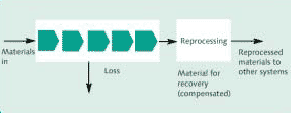
Figure 4.1
System with recovery of materials
Figure 4.1 illustrates a loss of materials during the product life-cycle. This may occur in the form of waste during production or in the form of incorrect disposal of the product when it is discarded. Table 2.2 (chapter B.2.) provides some rules of thumb on disposal routes for materials; these can be used if you do not know the method of disposal used.
Reprocessing is the first step of recovering the discarded product. Reprocessing materials such as glass, plastic, and paper/cardboard involves a so-called quality loss. This loss expresses a reduction in the quality of the material caused by reprocessing.
Table 4.1 illustrates the quality factor for a number of materials. This quality factor is to be multiplied by the quantity of the reprocessed material. The result is the actual useful quantity of reprocessed material, and this is the quantity which will be used for compensation. The compensation will be incorporated in the disposal phase.
Table 4.1
Quality loss associated with reprocessing
Material |
Factor |
Paper/cardboard |
0.8 |
Glass |
0.9 |
Metals |
1 |
Plastic |
0.8 |
In addition to the quality loss, you need to remember to include the actual reprocessing
process in your model. Table 3 in Appendix B provides some data for the process energy
used for reprocessing –these data can be used if you do not know the actual energy
consumption figures. In cases where the energy consumption for reprocessing is not known,
it is recommended that you use 50% of the energy consumed during the production phase as
an estimated figure.
The quantities of materials sent for reprocessing are taken either from the relevant production system or from the right-hand "column" in table 2.5 (chapter 2) under "disposal".

Figure 4.2
System without recovery
Incineration of products (plastic, paper, etc.) generates energy. This energy can be used for e.g. heating and so needs to be offset against the total environmental impact of the product in order to compensate for the positive contribution made. You should make sure that you offset this energy in your model simulation. Once again, compensation will occur during the disposal phase.
Energy recovery is calculated as the calorific value times the quantity of materials incinerated. The quantities of incinerated materials are taken from the relevant product system or calculated on the basis of the percentage listed in table 2.2 (chapter 2) under "disposal".
For products which comprise several materials, the calorific value must be estimated on the basis of the dominant materials used in the product. For mixed household waste, the calorific value can be set at 15 MJ/kg.
Example B4.1: |
Calculating the energy released as heat when incinerating plastic |
Incinerating 200 g polypropylene plastic generates energy, and you need to compensate for this energy in your assessment. The amount of energy to be compensated for is calculated like this: 0.2 kg x 40 MJ/kg = 8 MJ |
|
4.2.4 Modelling in the PC tool
This leaves the actual modelling in the PC tool. We recommend that you base your work on the MECO chart you prepared earlier. It can be helpful to prepare a flow diagram on the basis of the MECO chart.
Such a diagram gives you a better overview of what happens during the various life-cycle phases – where the inputs come from and where they end. Figure 4.3 shows a flow diagram for a coffee maker.
The flow diagram shown in figure 4.3 is different from the one featured in figure 2.1. The diagram in figure 4.3 has been chosen because it is consistent with the structure and system of the modelling.
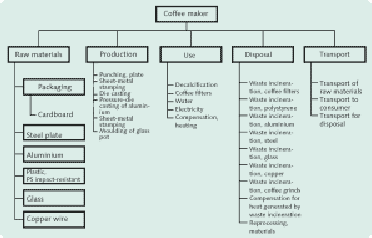
Figure 4.3
Flow diagram for a coffee maker
When you carry out modelling in the EDIP PC tool, you should refer to the manual for descriptions of how to proceed. The manual describes what you need to take into account, how to model your product, and how to handle data for a particular process, etc.
It is a good idea to check and ensure the quality of your model by letting others read it and offer comments – preferably before the modelling by means of the PC tool is initiated. |
Figure 4.4 shows the steps of the modelling. First, the product life-cycle is described,
then modelled. Following this, the PC tool will calculate the environmental impacts and
resource consumption.
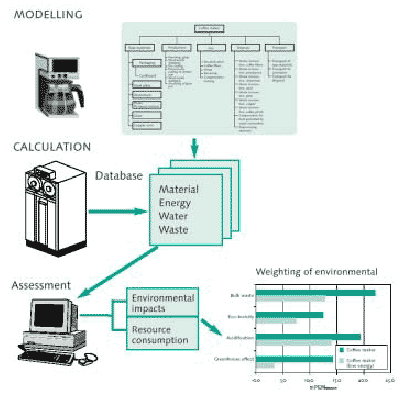
Figure 4.4
The stages of modelling
Modelling in the EDIP PC tool is based on a hierarchic structure of your model, as illustrated in example B4.2. The example shows the model for a coffee maker.
Example B4.2: Hierarchic model (coffee maker) in the EDIP PC tool The processes marked * were not in the database and so have been established in connection with the modelling. Furthermore, it should be noted that the energy consumption values for production of coffee filters and coffee are estimated values, and that use of washing-up liquid during the use phase has been omitted. |
|
1 coffee maker |
|
1 |
Material phase 1.12 kg plastic, polystyrene |
1 |
Production phase 0.2 m punching, metal sheet, 1-2mm |
1 |
Use phase 15 kg acetic acid |
1 |
Disposal phase 0.11 kg waste incineration, aluminium |
1 |
Transport phase 2,900,000 kgkm ship (raw materials) |
Generally speaking, the procedure will, of course, depend on the choice of tool. It will
also, however, depend on the person doing the modelling – after all, we all have our
ideas about the best ways to go about things. We do, however, recommend that the people
involved in the modelling agree on the structure. That makes it easier for others to read
and understand your model.
Once the modelling has been carried out and any missing, important impact factors have been entered into the database, the PC tool can calculate resource consumption and environmental impacts. This is to say that the PC tool carries out characterisation, normalisation, and weighting.
4.3 Interpret the environmental assessment in the PC tool
When you model your product by means of the PC tool, you will get a range of values for calculated contributions to various environmental impacts and resource consumption. These contributions are given in PE (Person Equivalents) and PR (Person Reserves) for environmental impacts and resource consumption, respectively.
In weighted results, the following units are used:
| 1 PEM corresponds to the average annual contribution which one person may make without exceeding the politically determined reduction targets for the year 2000 in the world (W) and Denmark (DK). | |
| 1 PR corresponds to the amount available of a given resource to a single person and his/her descendants in perpetuity. |
Please note that resource consumption is calculated per year in the PC tool, whereas it is calculated for the entire product life-cycle in the MECO chart. |
You can choose to present your results as normalised or weighted results by means of the
EDIP PC tools. The simplified environmental assessment method in this Handbook is based on
a presentation of weighted results. The weighted results give an assessment of the
seriousness of the environmental impacts and resource consumption associated with your
product.
If you need to use the results in a situation where the weighting factors in the chosen PC tool are not immediately recognised, you can choose to continue your work based on the normalised results.
In the EDIP PC tool, the weighting factors are based partly on the known supply horizon for non-renewable resources, and partly on the politically determined reduction targets for a number of environmental impacts.
4.3.1 The cause of the environmental impact of the product
In the interpretation, the cause of the individual environmental impacts must be identified and described. You should first consider the size of the individual impacts and assess which are large, and which are small. Then you should move on to determine the cause of the relatively "large" impacts.
Typical causes and resultant environmental impacts:
| Energy consumption will typically cause acidification, greenhouse effect, nutrients loads, and human toxicity. It will also generate waste types such as slag, ashes, and radioactive waste. | |
| Consumption of materials will drain resources and generate certain types of waste. | |
| Consumption of chemicals will often cause environmental impacts such as toxicity for human beings and the environment as well as photochemical generation of ozone. |
The weighted resource consumption and environmental impact potentials for the example with the coffee maker are calculated in the EDIP PC tool, and the results are presented in figures 4.5 – 4.6.
The unit mPEM stands for milli-person equivalents, targeted. mPEMWDK2000 means milli-person equivalents, targeted in the world and Denmark for the year 2000. The unit mPRW90 means milli-person reserves identified in the world in relation to the reference year, 1990.
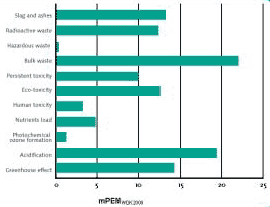
Figure 4.5
Weighted environmental impact potentials per year for the coffee maker (with a lifespan
of five years)
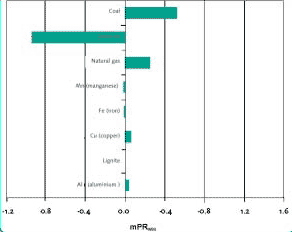
Figure 4.6
Weighted resource consumption per year for the coffee maker (with a lifespan of five
years)
Figure 4.6 shows considerable consumption of coal and natural gas. These resources are primarily used to generate Danish electricity, which is used to manufacture the coffee filters used during the use phase as well as for the actual coffee-making. The net consumption of crude oil is negative because we compensate for the heat generated from waste incineration during the disposal phase in the final result.
Figure 4.6 also shows that the use of a comparatively small amount of copper in the wire for the coffee maker entails a greater draw on resources than the use of aluminium, even though more aluminium is used. This is because copper is a scarce resource and so has been weighted higher than aluminium. Copper primarily contributes to eco-toxicity (see figure 4.5), whereas aluminium contributes to eco-toxicity and to the greenhouse effect and bulk waste (i.e. household waste, construction waste and similar waste disposed of at a municipal landfill. Such waste is characterised by not containing any substances that are dangerous to the environment).
Figure 4.5 shows that the most important environmental impacts concern the energy-related impacts such as greenhouse effect, acidification, human toxicity, and waste.
The EDIP PC tool shows many impacts, and of course not all of them are equally relevant to your environmental assessment. This is why we recommend that you select impacts which are relatively large for the next step of your work: the interpretation of the environmental assessment. We suggest that you select 3-5 impacts for further treatment. You should not, however, choose three waste categories.
4.3.2 Assigning impacts to phases with EDIP PC tools
Using an EDIP PC tool gives you the chance to assign the environmental impacts to the phases of the product life-cycle: raw materials, production, use, disposal, and transport.
4.3.2.1 Where are the most significant impacts found?
The opportunity to assign the various impacts to each phase will help make the causes behind the impacts more visible. You will be able to see how large a part of e.g. the greenhouse effect is caused during the raw materials phase or production phase. This is illustrated in figures 4.7 – 4.8, where the coffee maker’s contributions to environmental impacts and resource consumption have been assigned to their relevant phases. For example, the figures show that the contribution to the greenhouse effect stems primarily from the use phase.
Identifying the cause of the environmental impact will give you an overview the materials, processes, etc. which make up the environmental profile of your product. This overview can make it easier to point out the areas where changes could result in significant environmental improvements of your product.
All the figures below are also examples of how the results of the environmental assessment can be presented. It is a good idea to show the results divided into the various phases. Please note that the more impacts you show, the harder it will be to read your results. In the example with the coffee maker, four environmental impacts have been selected: greenhouse effect, acidification, eco-toxicity, and bulk waste. These four impacts were chosen because they are relatively large when compared to the other contributions (see figure 4.7). The resource consumption values have been selected on more or less the same basis – which is to say that the largest were chosen. In addition to this, the largest non-energy-related drains on resources have also been selected – copper and aluminium in this specific case.
In order to make comparisons of several products more easily accessible, it may be a good idea to show the environmental profiles of all the products in a single graph.
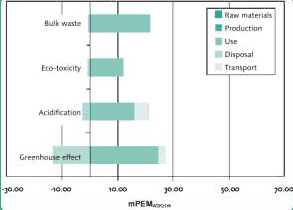
Figure 4.7
Weighted selected environmental impact potentials per year for the coffee maker, by
life-cycle phase
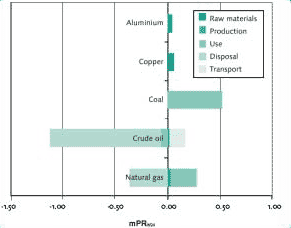
Figure 4.8
Weighted selected resource consumption values per year for the coffee maker, by phase
The listings by phase in figures 4.7 and 4.8 show that the use phase accounts for the majority of all environmental impacts and resource consumption. This is not surprising, as experience shows that energy consumption during the use phase often overshadows all the contributions from the other phases.
The elements for which compensation is made (the negative impacts shown in the figure) come from the heat and materials reprocessed during the disposal phase. This is to say that the total contributions are established by deducting the contributions from the reprocessed energy and materials from the contributions from the other phases.
4.3.2.2 Other impacts
In the example with the coffee maker, we have seen that the use phase is the most important in terms of environmental and resource consumption. If we omit the use phase from the overall picture, it becomes easier to identify the contributions made by the other phases of the coffee-maker’s life-cycle. See figures 4.9 and 4.10.
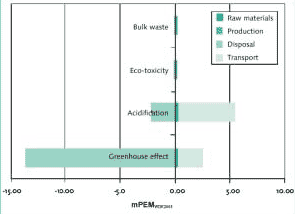
Figure 4.9
Weighted selected environmental impact potentials per year for the coffee maker, by
phase. The use phase has been omitted.
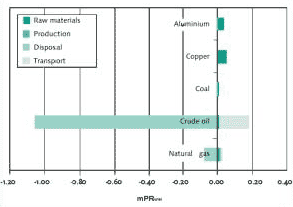
Figure 4.10
Weighted selected resource consumption values per year for the coffee maker, by phase.
The use phase has been omitted.
Leaving out the use phase in figures 4.9 and 4.10 establishes a clearer overview of the contributions made by the other phases. Please note that the scale of the y-axis is now different. As might be expected, the disposal phase is also significant. After all, the coffee maker is made from materials which entail a relatively high degree of heat recovery upon incineration.
The production and raw materials phases make only small contributions. The contributions from the production phase come primarily from the energy used in the different processes. The contribution from the raw materials phase stems from the materials used to manufacture the product.
The transport phase makes a greater contribution than the other phases. In total, the transport featured in the coffee-maker example is of little significance. Often, the transport phase is omitted, as it is usually only significant for products which are transported far and have short lifespans and/or are transported by plane.
4.3.3 Comparing two products
If you wish to compare two products, A and B, we recommend that you compare individual impacts and resource consumption values for each product.
4.3.3.1 General instructions
If product A involves an impact contribution which is 50% greater than the corresponding contribution from product B, this obviously means that product B is preferable as far as that particular impact is concerned. If the difference between the two products is less than 50%, it will usually not be possible to determine with absolute certainty which product is best in environmental terms. This is due to uncertainties in connection with data, calculations, etc.
It may be helpful to divide the environmental impacts into three types: global, regional, and local impacts. This gives you the opportunity to assign priorities to the environmental impacts depending on the company’s location, policies, etc. If, for example, the company is located in an urban environment, this entails certain requirements in terms of the impact on the immediate surroundings. Such requirements are different to those applying to a company located in a field with 10 km to the nearest neighbour. Example B4.3 illustrates one such comparison.
Example B4.3: Comparing products A and B
Once your comparison is complete, you will have a number of pluses and minuses to be assessed. Whether one product is better than another depends very much on which environmental impacts you regard as the most important. It may, for example, be crucial that your product does not have a strong toxic effect on the aquatic environment. If, for example, your company is located near a very sensitive aquatic environment, it would be most appropriate to choose product B in this particular case (due to its low eco-toxicity). It may also be that the environmental policy at your company is to aim for as little impact on the greenhouse effect as possible. If so, product A would the best choice in this particular case. |
As illustrated in example 4.3, many factors apply when comparing two products. Often, both products will offer certain advantages within different areas. |
For products with very similar life-cycles, you can simply assess the differences between
them. If the difference between two products is that one is made from 5 kg of aluminium
and the other is made from 2.5 kg plastic, you can settle for simply assessing the
environmental impact of the raw materials phase, the production phase, and the disposal
phase for the two products and then compare your results. This method is, however, only
useful in cases where the objective of the environmental assessment is to decide which of
the two products is best for the environment within a single, highly specific area. Such
an assessment says nothing about the products’ total impact on the environment or the
resource consumption associated with them. Nor does the assessment say anything about the
nature of the environmental impacts which the products contribute to. This means that an
environmental assessment of this kind does not tell you much about the overall
environmental impact of the products.
4.3.3.2 Example
The following shows an example of a comparison between two coffee makers. The difference between the two products is that one features lower energy consumption (200 kWh) during the use phase than the other product (the reference product), which has a corresponding energy consumption rate of 540 kWh.
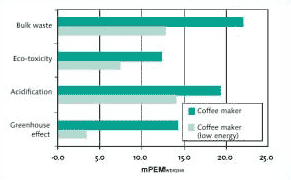
Figure 4.11
Environmental impact potentials per year for a comparison between two coffee makers
with energy consumption rates during the use phase of 200 and 540 kWh, respectively
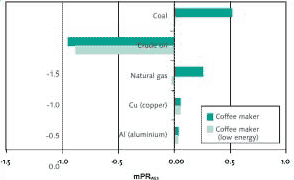
Figure 4.12
Resource consumption values per year for two coffee makers with energy consumption
rates during the use phase of 200 and 540 kWh, respectively
As expected, figures 4.11 and 4.12 show that the energy-related impacts are smaller for the coffee maker with the low rate of energy consumption. The difference may not appear as large as you would expect; this is because large quantities of energy are also expended on making coffee filters and coffee.
The example also illustrates that a manufacturer (in this case of coffee makers) cannot influence every aspect of the product life-cycle. Here, for instance, a reduction in energy consumption in connection with the coffee filters would improve the environmental profile of both coffee makers.
4.3.4 Uncertainties
Interpretation also includes an assessment of the uncertainties in your calculations. You should be aware that even small changes in your basic data can cause large changes in the environmental impacts calculated. You need to take this into account in your interpretation.
If your work involves data of inferior quality, you should consider how changes in these data could affect the overall result.
For example, the interpretation of your environmental assessment will not change if the change concerns the energy consumption for a process in the manufacture of a product which has a very large energy consumption compared to the other phases.
It may, however, affect your environmental assessment if you are working with a plastic product that contains lead and where it has not been possible to include this lead in your assessment because of insufficient data about the quantities.
4.4 Were your questions answered?
The interpretation of your environmental assessment should hopefully provide you with answers to the questions which caused the environmental assessment to be initiated in the first place. However, the results of the environmental assessment are not always sufficiently clear and unambiguous. For example, you may discover that the uncertainties associated with the data used are so significant that it is impossible to make decisions based solely on your environmental assessment. In such cases, it may be necessary to take the next step, possibly by collecting more data or by having more impact factors calculated.
For example, we might imagine that you have tried to compare two different types of plastic to identify the one with the least harmful impact on the environment. If your comparison shows that there is no difference between the two types of plastic, this may be because your assessment has not included data about additives, pigments, special ingredients, etc. In order to determine which of the two types of plastic is least harmful to the environment, it will be necessary to proceed by collecting data about the missing substances and by having an expert calculate impact factors which were not included the first time around.
In other cases, it may be sufficient to simply collect further data. You will typically have to collect further data in cases where you can see that a specific area – such as a process, a material, etc. – is very significant to the result of your environmental assessment. If some of the data used within this area are not specific or are exclusively based on assumptions, you should try to obtain more specific data. It may also be that your MECO chart includes notes about emissions or issues which you have not been able to include in your modelling. If these issues are significant to the overall environmental profile, you should collect further data. Section 4.5 contains more inspiration on how to collect extra data.
4.5 Collect more dataIf it is necessary to collect more data in order to obtain clearer answers from the environmental assessment, several options are open to you. Depending on the specific requirements involved – e.g. product and process relations, uncertainties, data age, etc. – data can be found in these places:
| Suppliers, customers, and other contacts | |
| Sector organisations | |
| Databases/literature | |
| Knowledge centres |
If you do not find the data you need, it may be necessary to use data from a similar process, or to make an estimate for e.g. the energy consumption for a process on the basis of your knowledge of the energy consumption for another process. In most cases, this option is regarded as preferable to using no data at all. Even so, it may only be possible to obtain data for impact factors from experts at knowledge centres.
The reference list includes examples of databases and other relevant literature where you might find useful data.
The more product-specific your data needs to be, the more relevant it would be to ask your suppliers for their environmental data.
Experience shows, however, that it takes a long time for suppliers to obtain the data you want. It is always important to phrase your questions as accurately as possible to avoid any misunderstandings about the data you need.
4.5.2 Sector organisations
If your supplier cannot give you the data you need, it may in some cases be useful to ask the relevant sector organisation. If you are lucky, they may have collected data which apply to the sector, or perhaps they can refer to someone who has the data you need. One example would be the Association of Plastics Manufacturers in Europe, APME. Within this sector, the manufacturers have chosen to publish general data on the manufacture of individual types of plastic seen within a life-cycle perspective.
4.5.3 Databases and literature
Various databases and literature can also be helpful. The type of data found in this way is, however, mostly general in nature, and is not always recent. Please note that such data usually predates the date of publication by 1-5 years.
4.5.4 Knowledge centres
Finally, you can ask the experts. It can be a good idea to draw on their experience and experience with data collection. This will often reduce data uncertainty.